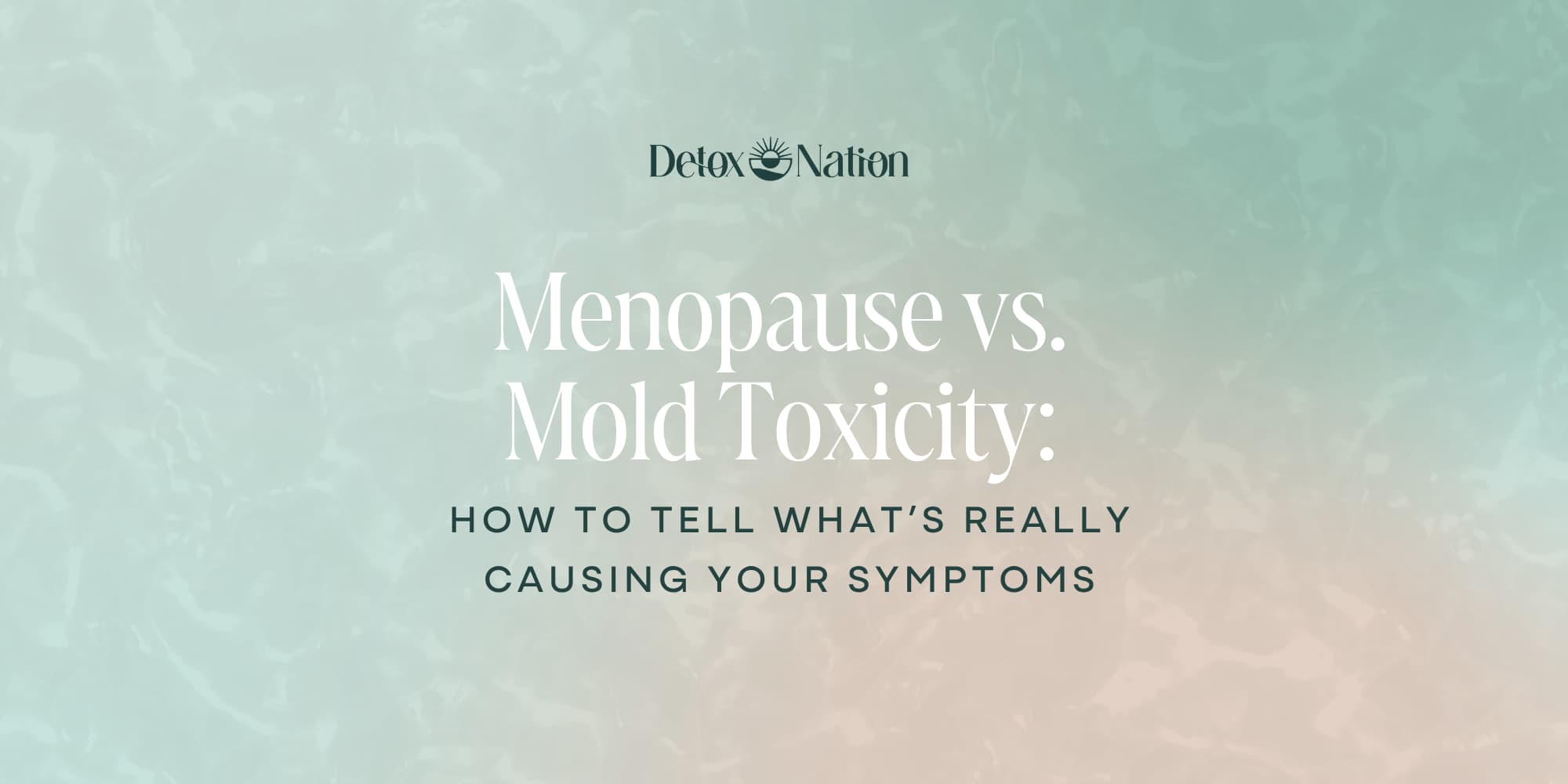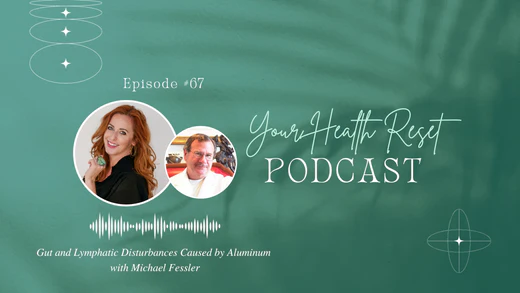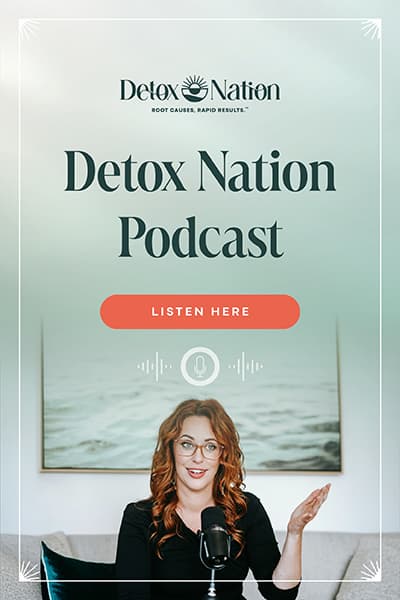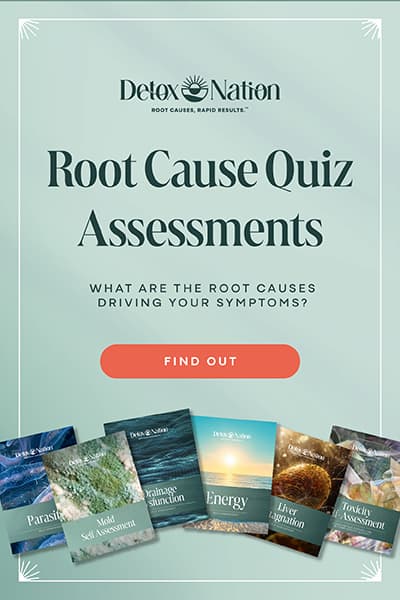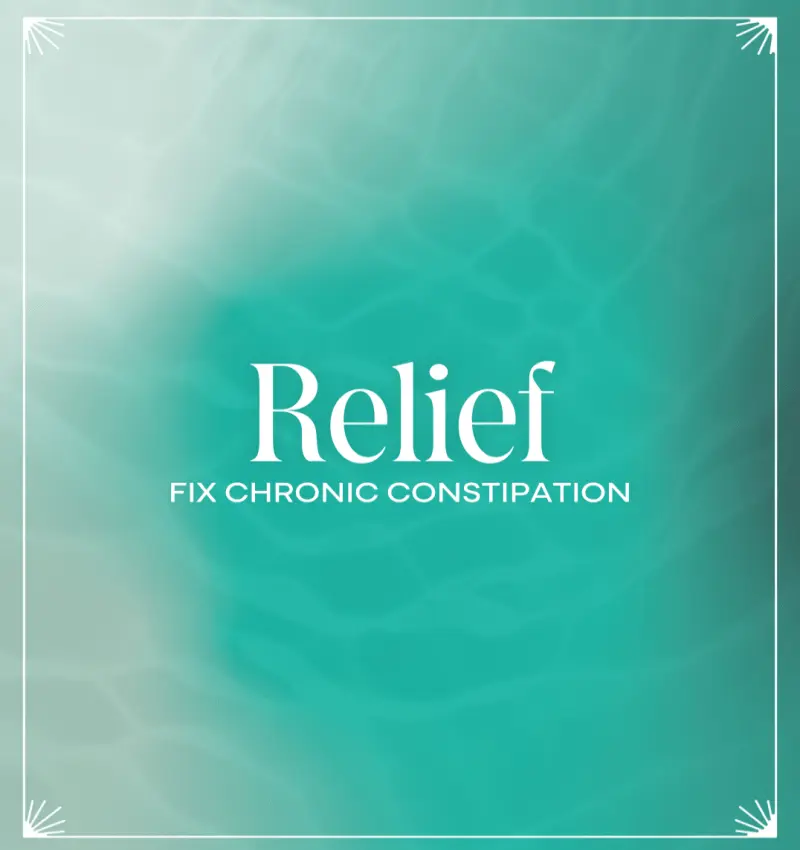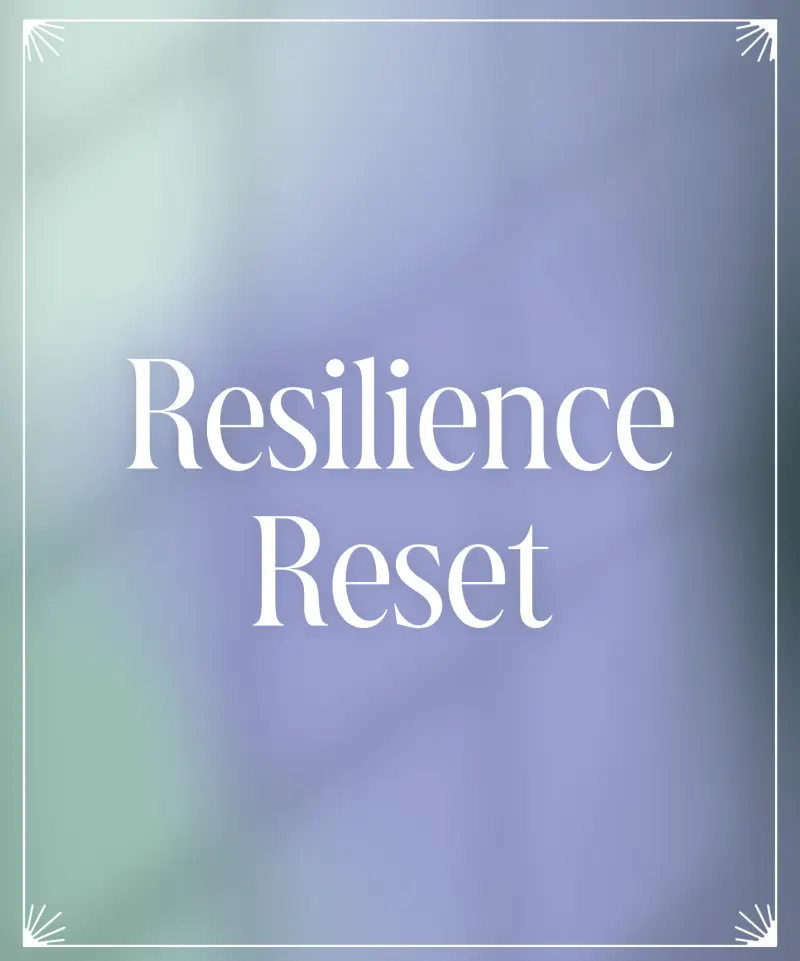Your signs and symptoms scream menopause, but what if it’s not just age, and your house is making it worse? Mold exposure can cause similar issues—plus respiratory problems, histamine intolerance, and chemical sensitivities. Don’t let mold toxicity go undiagnosed.
You wake up exhausted, despite getting a full night’s sleep.
Your joints ache like you just ran a marathon (you didn’t).
You’re gaining weight despite eating less, and your mood swings could scare a Navy SEAL.
Maybe it’s menopause.
Or maybe your house is poisoning you.
Before you resign yourself to “this is just aging,” let’s take a closer look.
Because while menopause absolutely plays a role in how you feel, mold toxicity can cause many of the same symptoms—plus some uncomfortable extras.
If no amount of clean eating, supplements, or self-care is moving the needle, it’s time to ask: Is this hormonal, or is it mycotoxins hijacking my system?
What Is Menopause? (And Why Does It Feel Like Your Body is Gaslighting You?)
Menopause is like a “software update” for your body—suddenly, the settings have changed, the thermostat is broken, and sleep mode malfunctions at random.
It’s the natural transition where your ovaries retire from hormone production, leaving you to navigate hot flashes, brain fog, and mood swings with nothing but sheer willpower and maybe a fistful of supplements (11).
The Three Stages of Menopause
- Perimenopause: Starts years before menopause, even in your 30s or 40s. Estrogen goes on a rollercoaster, and symptoms fluctuate wildly (11, 29). A common symptom during this time leading up to menopause is abnormal uterine bleeding (7).
- Menopause: Officially defined as having no menstrual period for 12 months (11, 17, 25, 29). The average age of menopause is between 45 and 55 years of age (29).
- Post-menopause: Your hormones come to grips with the new normal of low levels, but lingering symptoms can persist (8, 11, 16, 17, 25, 29).
Common Signs and Symptoms of Menopause
- Hot flashes & night sweats or vasomotor symptoms (2, 3, 9, 13, 14, 17, 18, 23, 24, 29, 30, 36) – It’s like your body’s internal thermostat just quit its job and started hitting random buttons instead. One minute, you’re fine—next, you’re drenched in sweat, stripping off layers like a malfunctioning radiator, and wondering if spontaneous combustion is a real thing.
With estrogen no longer regulating temperature control properly, your brain overreacts to the smallest shifts, triggering heat surges that can strike at the worst possible moments (hello, important meeting or dead sleep at 2 AM).
- Mood swings (8, 9, 13, 17, 18, 23, 29, 30) – Crying because you saw an old couple holding hands? Yep, that’s hormones. It’s like emotional whiplash—you’re fine one minute, then suddenly crying.
While estrogen and progesterone play an unpredictable game of musical chairs, serotonin and GABA (your chill-out neurotransmitters) take a hit, leaving you more irritable, anxious, or prone to existential crises over minor inconveniences.
- Brain fog (3, 9, 17, 18, 23, 34) – Walking into a room and forgetting why? Classic. The cognitive effects of menopause are real. With estrogen on the decline, so is its support for neurotransmitters like acetylcholine (which keeps memory sharp) and blood flow to the brain, making even simple tasks feel like mental gymnastics.
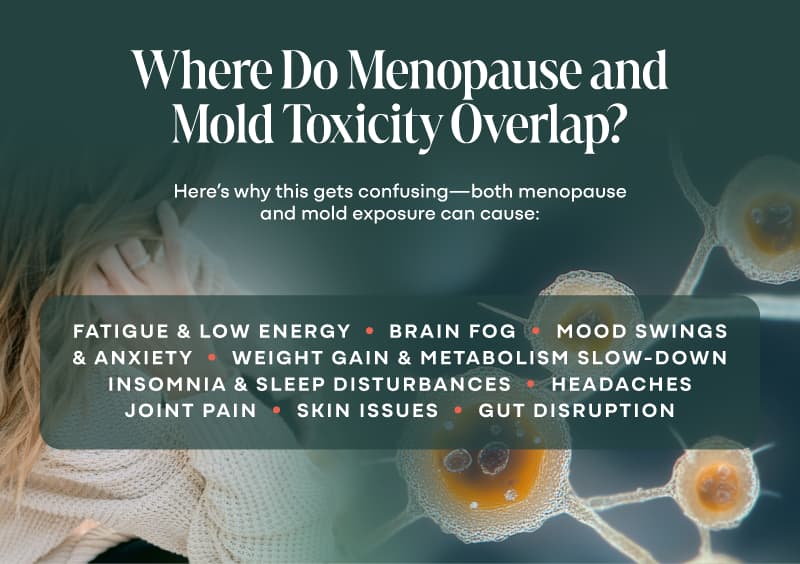
Add in poor sleep, stress, and fluctuating blood sugar, and suddenly, remembering where you put your keys feels like a CSI-level investigation.
- Weight gain & metabolic changes (9, 17, 18, 23, 29) – Your body now stores everything as an “emergency fund.”
- Insomnia & disrupted sleep (3, 9, 13, 14, 17, 18, 23, 24, 25, 34, 36) – Because 2 AM is clearly the best time to stare at the ceiling. Trouble falling asleep, trouble staying asleep, waking up too early, and increased daytime sleepiness all fall into this category. Sound familiar?
- Skin issues – Menopause skin is like that one houseplant you forgot to water—suddenly dry, sagging, and looking a little…defeated. With estrogen on the decline, collagen production slows, elasticity takes a nosedive, and your once-plump, dewy skin starts acting like a desert, making every wrinkle, irritation, and mystery rash way more noticeable. Changes can also include facial hair growth, loss or thinning of scalp hair, and acne (9, 14, 18, 29).
- Decreased libido (6, 13, 18, 29, 34) – Your once-roaring bonfire is now just a pile of lukewarm embers—technically still there, but not exactly lighting up the night. With estrogen and testosterone taking a dip, arousal becomes more of a mental negotiation than a spontaneous event. (And thanks to vaginal dryness and fatigue, sometimes a good nap just sounds way more appealing.)
- Genitourinary symptoms – Physical changes to the vulva and vagina, incontinence, UTIs, vaginal dryness, and pain with intercourse (4, 5, 6, 9, 13, 24, 29, 30, 33, 34, 37).
With estrogen in short supply, vaginal tissue gets thinner, drier, and less elastic (think: crepe paper instead of silk), making sex uncomfortable and UTIs way more frequent. Meanwhile, your bladder, which was once a reliable teammate, suddenly develops a mind of its own—urgency, leakage, and nighttime bathroom trips become the new norm.
- Joint pain (13, 18, 24, 34) – Menopausal joint pain is like waking up in a body that suddenly thinks it’s 30 years older than it is—stiff, creaky, and weirdly achy for no good reason. With estrogen on the decline, inflammation ramps up, cartilage loses its cushion, and your once-springy joints start protesting basic activities like standing up or reaching for your coffee.
- Dyslipidemia (32, 35) – With estrogen stepping out of the picture, LDL (“bad” cholesterol) creeps up, HDL (“good” cholesterol) takes a hit, and triglycerides start throwing a little party in your bloodstream. Since estrogen is used to help keep your lipids in check, its decline means your metabolism and heart health need extra attention.
- Central Fat Accumulation (10, 23, 24, 26, 29) – It’s like your body suddenly decided that your midsection is the perfect place to store everything—even if you’re eating the same and working out like usual. During the menopause transition, your metabolism slows, cortisol rises (hello, stress belly), and your body shifts to storing fat in the abdomen instead of the hips and thighs.
- Digestive disruption (18, 27) – think bloating, gas, IBS – Menopausal digestive disruption is like your gut suddenly forgot how to do its job—foods you used to handle just fine now cause bloating, acid reflux, or bathroom emergencies.
With hormones declining, stomach acid production drops, bile flow slows, and your gut microbiome shifts, making digestion sluggish and unpredictable. Add in stress (which is basically gasoline on the fire), and suddenly, your favorite meals feel like a betrayal.
All of this sounds bad enough, but here’s the problem: mold exposure can cause nearly identical symptoms—and worse.
Ready to Take the First Step?
Discover how to boost your energy, support your body through menopause, detox from mold, and handle all the things life throws your way.
Join Rapid Energy ResetWhat Is Mold Toxicity?
Mold toxicity (aka mycotoxin illness) happens when you’re exposed to certain mold species that produce invisible, airborne toxins.
These bioactive poisons hijack your immune system, brain, hormones, and mitochondria.
“But I live in a new house” or “I don’t have mold” people reflexively say.
Consider this: Mold exposure is cumulative.
Also, once mold enters your body (commonly via inhalation), it can colonize in your sinuses (or other warm, moist areas) within twenty-four hours.
It snuggles into your tissues and covers itself with a protective layer called a biofilm, which hides it from your immune system (42, 45).
From there, it can live its life.
Reproduce.
And continuously pump out mycotoxins that suppress your immune system, damage your gut, cross your blood-brain-barrier, and make you sick for months or years after exposure (43, 46).
Maybe it’s time to reflect upon your lifetime mold exposures.
Where Mold Hides
- Water-damaged walls, ceilings, and HVAC systems
- Leaky roofs, attics, and basements
- Old books, furniture, carpets, and even your clothes
- Poorly ventilated bathrooms and under-sink areas
- Old, musty storage units
- And even leaky cars
If you live in a humid climate or a home with past water damage, your risk skyrockets. (Looking at you, Florida!)
And if you feel better when you leave your house for a few days? That’s a red flag.
Common Symptoms and Causes of Mold Toxicity
- Crushing fatigue (39, 40, 44) – No amount of sleep helps. Your fatigue is completely out of proportion to your activity level.
- Brain fog – Not just forgetfulness—full cognitive impairment (39, 40, 43, 44, 56, 58). Mold-induced cognitive issues feel heavier, more constant, and borderline disorienting, like your brain is running on dial-up while the rest of the world is on fiber optic. Mycotoxins inflame the brain, mess with neurotransmitters, and hijack your mitochondria, leaving you forgetful, mentally exhausted, and struggling to process simple information.
- Anxiety, depression, or rage attacks (56)– Because mycotoxins wreck your nervous system.
- Weight gain & inflammation (39, 40, 43, 54) – Mycotoxins mess with metabolism, disrupt hormone balance, and overload detox pathways, leaving your body inflamed, stressed, and holding onto weight like it’s bracing for a famine—especially around the belly.
Worse, mold exposure can drive insulin resistance, thyroid dysfunction, and leptin resistance (60), meaning your hunger signals, fat storage, and energy production are all out of sync.
- Insomnia & vivid nightmares (39, 56) – Your body knows something’s wrong. Mold toxicity insomnia is like your brain forgot how to power down—wired but exhausted, staring at the ceiling, wondering why sleep feels impossible.
Mycotoxins batter your nervous system, disrupt melatonin production, and spike cortisol at the worst times, leaving you tired all day but restless at night. On top of that, mold exposure can trigger histamine intolerance and inflammation in the brain, making you wake up overheated, heart racing, or drenched in sweat.
- Immune suppression (26, 39, 40, 44) – Mycotoxins don’t just annoy the immune system—they confuse, exhaust, and overwork it, leading to chronic infections, relentless fatigue, and a “sick but not sick” feeling that doctors love to dismiss.
Over time, your immune response either overreacts (cue histamine issues, food sensitivities, and autoimmune flares) or checks out completely (hello, mystery illnesses that never go away).
- Respiratory issues (39, 40, 44, 57) – Mold toxicity’s respiratory issues are like living with an invisible fog machine that never turns off—chronic congestion, a nagging cough, shortness of breath, and lungs that feel tighter than they should.
Mycotoxins inflame the airways, disrupt oxygen exchange, and can even trigger asthma-like reactions, making every breath feel like extra work. Mold exposure can lead to sinus infections that never really clear and that constant tickle in your throat.
- Joint pain (55) – Mold toxicity joint pain is like waking up in a body that suddenly feels decades older—stiff, achy, and acting like you just ran a marathon when all you did was sleep. Mycotoxins trigger chronic inflammation, disrupt collagen production, and impair your mitochondria, leaving your joints feeling sore, inflamed, and mysteriously cranky for no obvious reason.
Mold exposure can also mess with pain signaling, making normal aches feel exaggerated, like your body’s volume knob is stuck on “ouch.”
- Skin Issues (41, 44, 55) – Mold toxicity skin issues are like your body’s way of getting your attention—rashes, itching, hives, weird breakouts, or just skin that suddenly hates everything. Mycotoxins overload the liver, disrupt detox pathways, and jack up histamine levels, leaving you extra sensitive to foods, skincare products, and even your own sweat.
One day, you’re fine—next, you’re dealing with eczema, mystery rashes, or that “crawling” feeling under your skin that no lotion can fix.
- Gut issues (27, 40, 41, 42, 47, 48, 49, 50, 51, 52, 53) – Bloating, food sensitivities, reflux, and bathroom roulette (constipation one day, urgency the next) are part of your daily life. Mycotoxins wreck gut balance by disrupting stomach acid, slowing bile flow, and wiping out beneficial bacteria, making it harder to break down food and absorb nutrients.
They damage the gut lining, leading to leaky gut, histamine intolerance, and inflammation that makes you react to foods you used to eat just fine.
Sound like menopause?
That’s why so many women get misdiagnosed—or dismissed altogether.
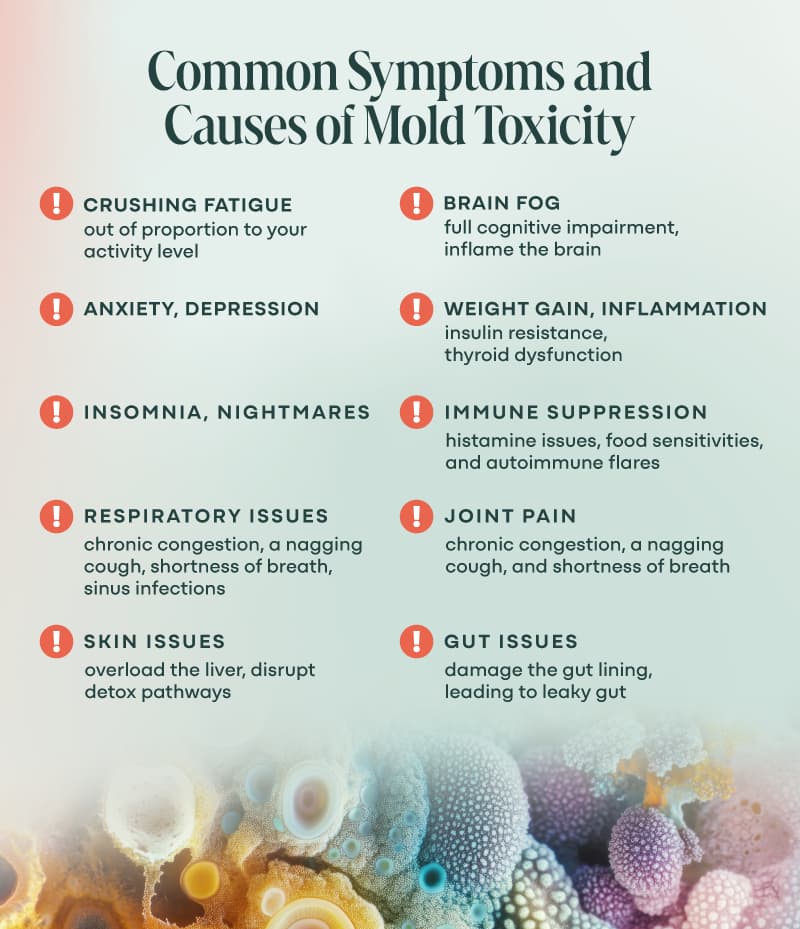
Where Do Menopause and Mold Toxicity Overlap?
Here’s why this gets confusing—both menopause and mold exposure can cause:
- Fatigue & low energy – Because both disrupt mitochondrial function.
- Brain fog – You’re constantly searching for words or feeling spaced out.
- Mood swings & anxiety – Estrogen drop or neurotoxic mold? Either way, you’re not yourself.
- Weight gain & metabolism slow-down – Mold disrupts thyroid, insulin, and estrogen.
- Insomnia & sleep disturbances – Hormones or environmental toxins? Could be both.
- Headaches – Hormones, sinus pressure, stress or all the above?
- Joint pain – The effects of low estrogen or those pesky mycotoxins?
- Skin issues – It can be hard to tell if it’s a hormonal imbalance or a detox issue or the combination of factors.
- Gut Disruption – I get it! At this point, you may be so sick of these symptoms that you don’t care, but figuring out which are caused by hormones, and which are caused by mold can be the first step in feeling like yourself again.
So, how do you separate what’s menopause from what’s mold?
Key Differences: Is It Menopause or Mold?
When trying to parse out symptoms of menopause from symptoms of mold exposure, paying attention to the details can help!
Here are some examples of ways you can look at your symptoms to figure out where they’re coming from.
Just remember, you can be going through menopause AND facing mold toxicity at the same time.
Equally important to remember? These things are FIXABLE.
- Onset
- If your symptoms came on gradually, alongside irregular periods, think menopause.
- If your symptoms hit you suddenly after moving homes, remodeling, or a water leak? Think mold.
- Location
- Menopause: Symptoms stay the same wherever you go.
- Mold: For example, if you feel better on vacation and worse when you come home, that’s a huge red flag.
- Chemical Sensitivities
- Menopause: No significant change.
- Mold: Suddenly can’t tolerate perfumes, cleaning products, alcohol, or other chemicals? That’s your liver screaming for help.
- Electric Zaps & Tingling Sensations
- Mold triggers nerve damage that feels like creepy-crawly sensations, tingling, or even random electrical zaps in your body (39, 43).
- Chronic Sinus Issues & Post-Nasal Drip
- Mold exposure inflames your sinuses—if you always feel congested or like you have a never-ending cold, this could be why.
- Fatigue
- Menopause: Poor sleep due to night sweats, hormonal fluctuations, or pain may cause extreme fatigue. But, if you manage to get a good night’s sleep, the exhaustion improves slightly.
- Mold: The fatigue feels constant and crushing no matter how much you sleep. You may also have respiratory symptoms, and it can change depending upon your environment.
- Digestive Distress
- Menopause: Symptoms often worsen with stress, caffeine, alcohol, and processed foods (due to increased gut sensitivity and slower digestion).
-
- Mold: Symptoms flare unpredictably and may get worse in damp environments, after eating high-histamine foods, or after poor sleep (since mold toxins disrupt detox and immune function).
The bottom line? Your chronic symptoms can be from menopause, mold exposure, or both.
To make things a little more complicated, menopause can make you more vulnerable to mold exposure. (Still fixable!)
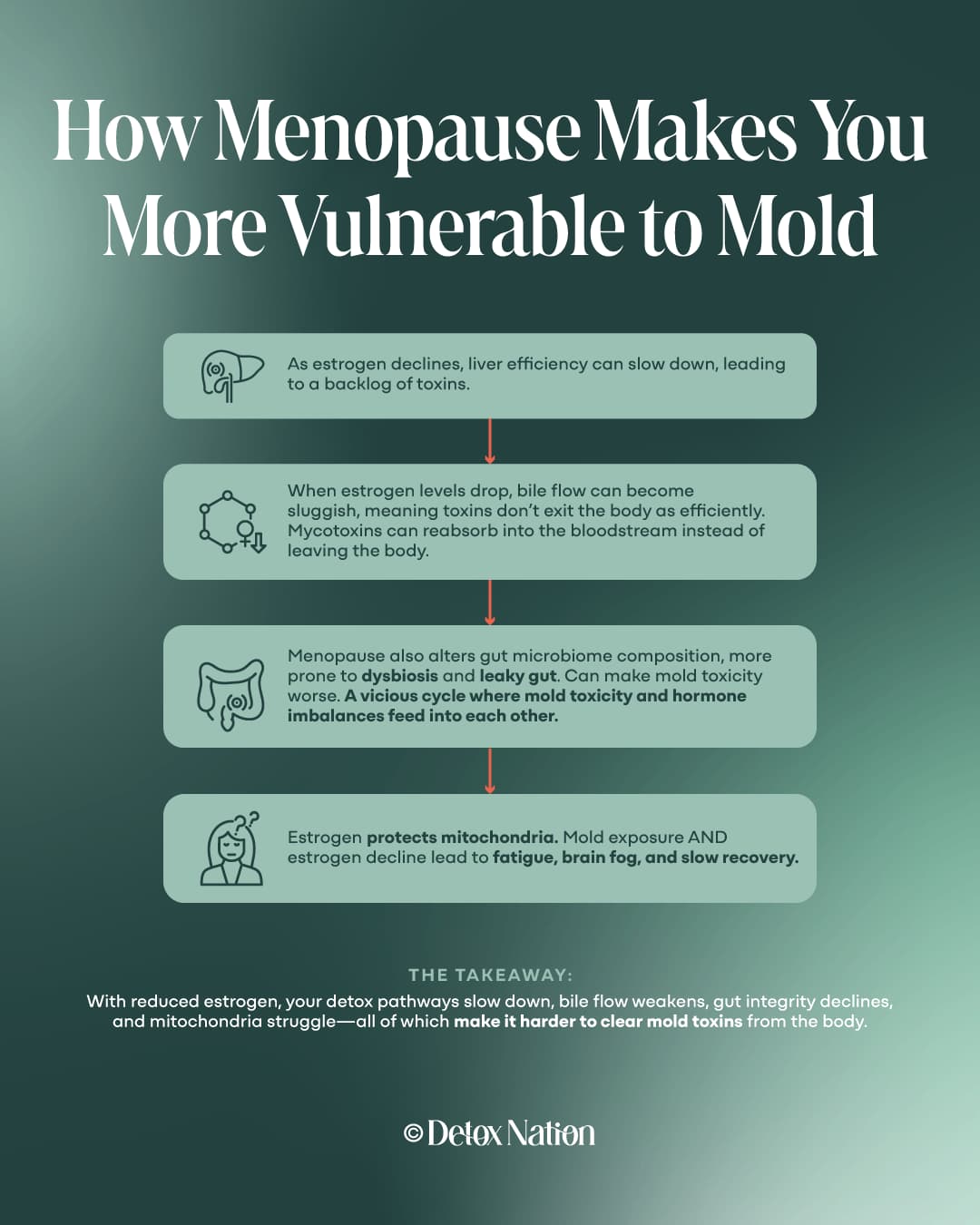
How Estrogen Changes Impact Detox Pathways—And Why That Makes You More Vulnerable to Mold
When estrogen levels fluctuate—like in perimenopause and menopause—your body’s natural detoxification processes take a hit. Here’s why:
1. Estrogen Supports Liver Detoxification
Your liver is the master detox organ, responsible for breaking down everything from environmental toxins to excess hormones.
Estrogen helps regulate Phase I and Phase II liver detox, ensuring that toxins are efficiently processed and excreted.
- Phase I Detox (Oxidation, Reduction, Hydrolysis): This is the first line of defense, where toxins (including mold mycotoxins) are broken down into intermediate forms.
- Phase II Detox (Conjugation): This is where those broken-down toxins get neutralized and packaged up for elimination via urine, sweat, and bile.
As estrogen declines, liver efficiency can slow down, leading to a backlog of toxins—including mold mycotoxins—that can recirculate in the body rather than being eliminated.
2. Estrogen and Bile Flow (a Key Route for Toxin Elimination)
Bile isn’t just for digesting fats—it’s also a primary way your body dumps toxins, including mold mycotoxins (48).
Estrogen helps keep bile production strong and flowing (59).
But when estrogen levels drop, bile flow can become sluggish, meaning toxins don’t exit the body as efficiently (59).
This is a double whammy because mold mycotoxins are often fat-soluble, meaning they rely on healthy bile production for clearance.
If bile isn’t moving, mycotoxins can reabsorb into the bloodstream instead of leaving the body.
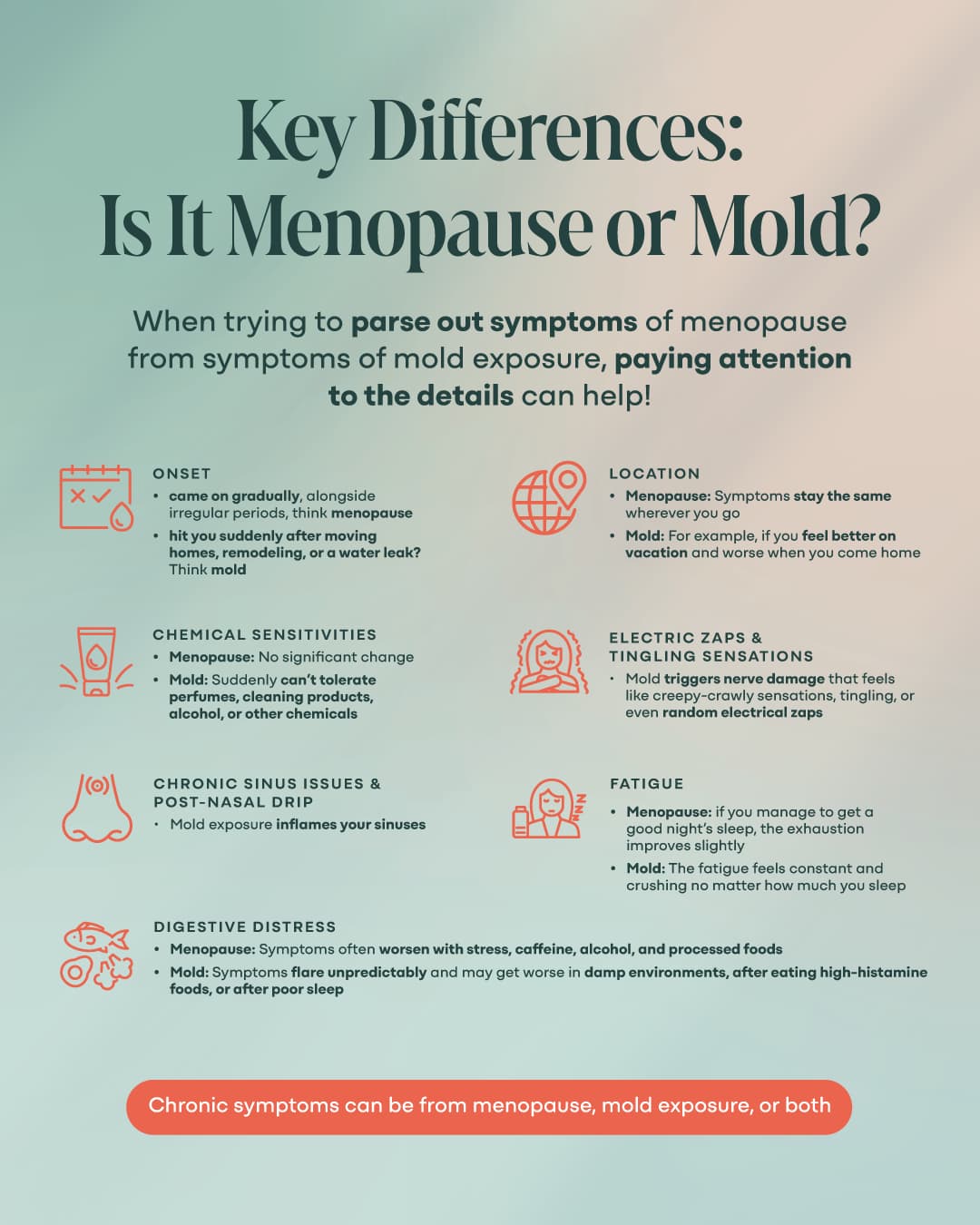
3. The Gut Connection: Estrogen, Mold, and Dysbiosis
Menopause also alters gut microbiome composition, making women more prone to dysbiosis (imbalanced gut bacteria) and leaky gut—both of which can make mold toxicity worse.
- Certain gut bacteria help metabolize estrogen, so when estrogen levels drop, gut health can decline.
- Mold toxins themselves can disrupt gut integrity, making you more vulnerable to inflammation, food sensitivities, and poor nutrient absorption.
The result?
A vicious cycle where mold toxicity and hormone imbalances feed into each other, making symptoms worse.
4. Mitochondria Take a Hit
Estrogen protects mitochondria, the tiny powerhouses of your cells that generate energy.
Mycotoxins are known mitochondrial poisons, meaning mold exposure AND estrogen decline lead to fatigue, brain fog, and slow recovery from stress or exercise.
The Takeaway: Why Mold Hits Harder During Menopause
With reduced estrogen, your detox pathways slow down, bile flow weakens, gut integrity declines, and mitochondria struggle—all of which make it harder to clear mold toxins from the body.
What might have been a mild exposure in your 30s can suddenly become a full-blown health crisis in your 40s and 50s.
(Still fixable!)
Bringing it All Together
If your doctor tells you “it’s just menopause” but you feel much worse than expected, mold might be the missing piece.
Menopause doesn’t usually come with chemical sensitivity, tingling nerves, or worsening symptoms at home. Mold does.
The key to feeling better?
- Identify and remediate mold exposure in your home.
- Support your drainage and detox pathways so toxins leave your body. (Think infrared sauna, rebounding, dry brushing, and binders.)
- Rebuild your energy & hormone balance through lifestyle upgrades. Eat to nourish your body, take appropriate supplements, stay hydrated with distilled water, reduce exposures to chemicals, EMFs, toxic seed oils, and more.
You don’t have to accept feeling terrible as “normal.”
Trust your body. If something feels wrong, keep digging.
Ready to take the first step? I invite you to our Rapid Energy Reset where I share the tools and strategies to help you reclaim your health, whether you’re struggling with menopause, mold, or allll the things.
Because your health is worth fighting for.
Ready to Take the First Step?
Discover how to boost your energy, support your body through menopause, detox from mold, and handle all the things life throws your way.
Join Rapid Energy ResetFAQs
1. Can menopause cause extreme fatigue like mold toxicity?
Yes, but there’s a difference. Menopausal fatigue is often linked to hormone fluctuations, poor sleep, and blood sugar imbalances. A key sign of mold toxicity? You wake up just as exhausted as when you went to bed, even if you slept 8+ hours.
2. I have brain fog—how do I know if it’s from menopause or mold?
Menopausal brain fog is usually inconsistent—some days you feel sharper, others you’re searching for words. It’s directly tied to hormonal fluctuations. Mold-related brain fog is persistent and feels like you’re thinking through molasses 24/7.
3. If it’s mold, why does my doctor keep telling me it’s just aging?
Because conventional medicine doesn’t recognize mold toxicity as a real problem. Most doctors aren’t trained to connect environmental toxins to chronic symptoms, so they default to “it’s just menopause” or offer antidepressants. If your symptoms don’t match what your doctor is telling you, trust your instincts and seek out a mold-literate practitioner.
4. Can mold make menopause symptoms worse?
Yes! Mycotoxins disrupt hormone balance, metabolism, and inflammation, making menopausal symptoms more extreme.
For example:
- Hot flashes? Mold toxins increase inflammation, worsening heat regulation.
- Weight gain? Mold disrupts thyroid, estrogen, and insulin function, making it impossible to lose weight.
- Mood swings & anxiety? Mycotoxins interfere with neurotransmitters like serotonin and dopamine.
So, if menopause feels worse than it should, mold could be fueling the fire.
5. I don’t see visible mold—could I still be exposed?
Absolutely. Hidden mold is the most dangerous kind because it releases toxins without obvious signs.
It could be:
- Inside walls from a past water leak or flood
- In your HVAC system, circulating mold spores
- Under bathroom sinks, dishwashers, or washing machines
Even if you don’t see it, you can feel it. If your symptoms improve when you travel or spend time outdoors, suspect hidden mold.
6. Can I detox from mold without leaving my home?
If your home still has mold, detoxing is like bailing out a sinking boat without fixing the leak. First, address the exposure, then focus on detoxing.
7. Will hormone therapy fix mold toxicity?
Not really. Hormone therapy can relieve menopause symptoms, but if mold is the root cause, your body will stay inflamed and out of balance.
If you suspect mold, address detox and inflammation first before adding in hormone support.
8. Can diet help with mold recovery?
Yes! Mold toxins thrive on inflammation and sugar, so adjusting your diet can make a huge difference.
Best foods for mold detox:
- Cruciferous veggies (broccoli, cauliflower, Brussels sprouts) for liver detox
- Bitter greens (arugula, dandelion, cilantro) to support bile flow
- Wild-caught fish & grass-fed meat for anti-inflammatory fats
- Garlic, onions, and ginger to support the immune system
Foods to avoid:
- Sugar & refined carbs – Mold toxins love feeding off glucose
- Dairy – Can worsen inflammation in sensitive individuals
- Alcohol – Stresses the liver when it needs to detox
9. How long does it take to feel better after addressing mold?
It depends on how long you were exposed, how well your detox pathways work, and your overall health.
- Some people feel dramatic improvement within weeks after leaving a moldy environment.
- Others need several months of detoxing before symptoms start to fade.
If your body has been overloaded for years, full recovery takes time—but it’s absolutely possible.
10. Are menopause and the symptoms associated with menopause normal?
Menopause is not a disease. Menopause is a natural process women experience that marks the end of their reproductive years. While some women experience symptoms for several years, or the continuation of symptoms for years after menopause, common symptoms of menopause last several years. The transition in menopause is usually accompanied by symptoms like hot flashes, as well as other physical and emotional symptoms. Menopause symptoms may be exacerbated by mold toxicity and other toxic exposures.
